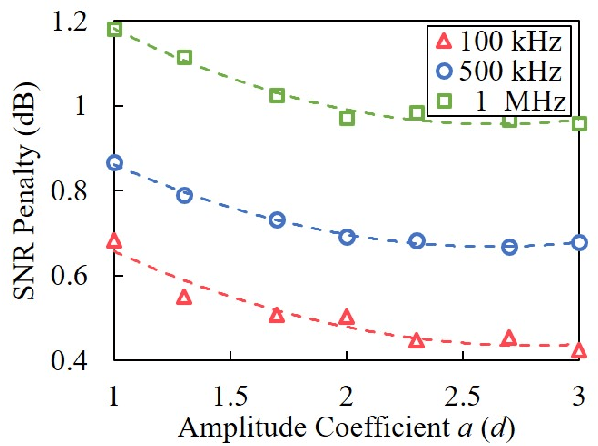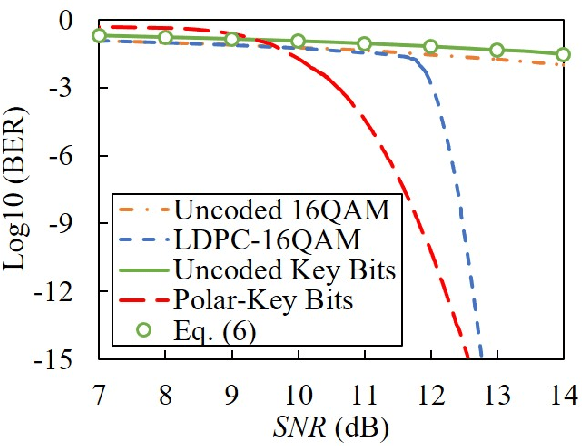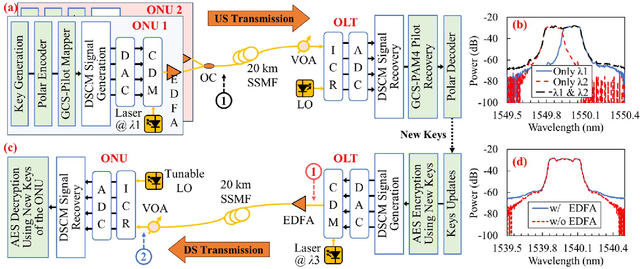Jianrui Zeng
Pilot-Based Key Distribution and Encryption for Secure Coherent Passive Optical Networks
Nov 05, 2023



Abstract:The security issues of passive optical networks (PONs) have always been a concern due to broadcast transmission. Physical-layer security enhancement for the coherent PON should be as significant as improving transmission performance. In this paper, we propose the advanced encryption standard (AES) algorithm and geometric constellation shaping four-level pulse amplitude modulation (GCS-PAM4) pilot-based key distribution for secure coherent PON. The first bit of the GCS-PAM4 pilot is used for the hardware-efficient carrier phase recovery (CPR), while the second bit is utilized for key distribution without occupying the additional overhead. The key bits are encoded by the polar code to ensure error-free distribution. Frequent key updates are permitted for every codeword to improve the security of coherent PON. The experimental results of the 200-Gbps secure coherent PON using digital subcarrier multiplexing show that the GCS-PAM4 pilot-based key distribution could be error-free at upstream transmission without occupying the additional overhead and the eavesdropping would be prevented by AES algorithm at downstream transmission. Moreover, there is almost no performance penalty on the CPR using the GCS-PAM4 pilot compared to the binary phase shift keying pilot.
Non-Integer-Oversampling Digital Signal Processing for Coherent Passive Optical Networks
Jun 20, 2023Abstract:Beyond 100G passive optical networks (PONs) will be required to meet the ever-increasing traffic demand in the future. Coherent optical technologies are the competitive solutions for the future beyond 100G PON but also face challenges such as the high computational complexity of digital signal processing (DSP). A high oversampling rate in coherent optical technologies results in the high computational complexity of DSP. Therefore, DSP running in a non-integer-oversampling below 2 samples-per-symbol (sps) is preferred, which can not only reduce computational complexity but also obviously lower the requirement for the analog-to-digital converter. In this paper, we propose a non-integer-oversampling DSP for meeting the requirements of coherent PON. The proposed DSP working at 9/8-sps and 5/4-sps oversampling rates can be reduced by 44.04% and 40.78% computational complexity compared to that working at the 2-sps oversampling rate, respectively. Moreover, a 400-Gb/s-net-rate coherent PON based on digital subcarrier multiplexing was demonstrated to verify the feasibility of the non-integer-oversampling DSP. There is almost no penalty on the receiver sensitivity when the non-integer-oversampling DSP is adopted. In conclusion, the non-integer-oversampling DSP shows great potential in the future coherent PON.
Timing Recovery for Point-to-Multi-Point Coherent Passive Optical Networks
Apr 11, 2023Abstract:We propose a timing recovery for point-to-multi-point coherent passive optical networks. The results show that the proposed algorithm has low complexity and better robustness against the residual chromatic dispersion.
 Add to Chrome
Add to Chrome Add to Firefox
Add to Firefox Add to Edge
Add to Edge